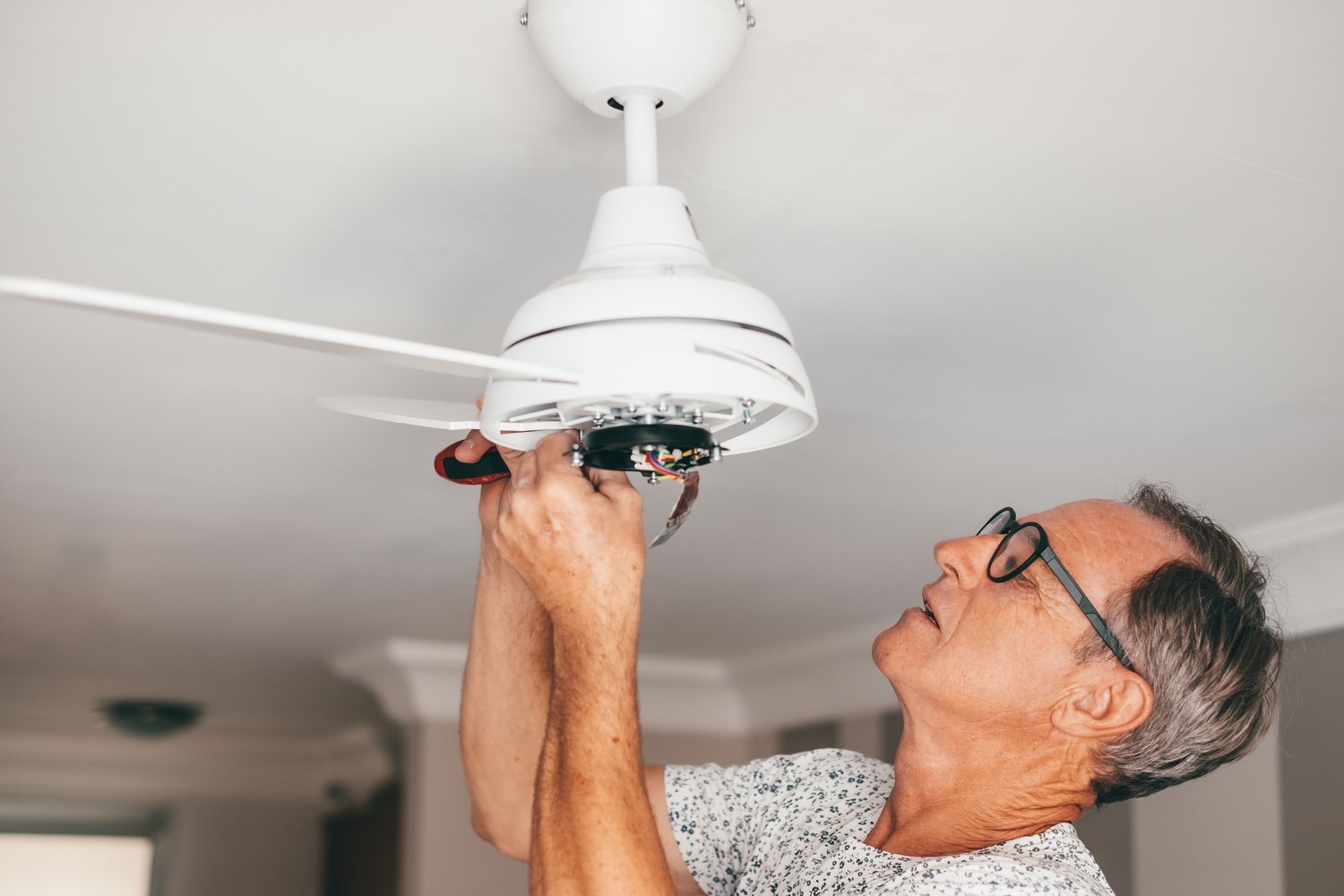Is your ceiling fan turning into a noisy nuisance? An imbalanced fan isn’t just bothersome; it can also lead to premature wear and tear. Mastering the art of balancing your ceiling fan can enhance its performance dramatically, making your home a serenely breezy haven.
- Explore the basics of ceiling fan balance and uncover the sneaky culprits behind that pesky wobble.
- Discover the essential toolkit to equip yourself for a seamless balancing adventure.
- Unlock step-by-step strategies to tackle fan imbalances, ensuring a smooth and wobble-free operation.
- Learn long-term maintenance hacks to keep your fan in optimal condition effortlessly.
By diving into this guide, you’ll gain practical skills to extend your fan’s lifespan and create a calm, comfortable atmosphere in your home. Embark on this journey and transform your ceiling fan from an irritation into a whisper-quiet ally.
Understanding the Ceiling Fan Balancing Guide Essentials
Balancing a ceiling fan is crucial for ensuring its smooth operation and extending its lifespan. When a ceiling fan is properly balanced, it not only enhances air circulation but also operates quietly, contributing to a comfortable living environment.
Ceiling fan wobbling is typically caused by a variety of factors. Uneven blade weights are one of the most common reasons. Even a minor discrepancy in blade weight can lead to significant wobbling, which is both annoying and potentially damaging to the fan’s motor over time.
Another cause of ceiling fan imbalance is poor blade alignment. Blades that are not equidistant from each other or are not mounted at the same angle can result in a noticeable wobble. Additionally, loose screws or fixtures can contribute to the imbalance, as they allow the blades to move more freely than intended.
Understanding these fundamentals of ceiling fan operation will lay the groundwork for successfully troubleshooting and resolving any issues that arise. Recognizing the signs of an unbalanced fan and knowing the potential causes are key to making the necessary adjustments for a wobble-free fan.
Tools You’ll Need for the Job
To effectively balance your ceiling fan, having the right tools on hand is essential. Start by gathering the basic necessities. A screwdriver set is indispensable for adjusting screws and fixing loose elements.
A stepstool or ladder will provide safe access to the fan, ensuring you can examine and modify the blades without straining. For checking the weight distribution and balance of the blades, a specialized fan balancing kit can be incredibly helpful. These kits typically include adhesive weights and a balancing clip, which are instrumental in fine-tuning the fan’s balance.
Additionally, having a measuring tape can assist in verifying that all blades are equidistant from the ceiling, which is crucial for proper alignment. Although not mandatory, a level can offer additional assurance that your fan is correctly aligned with the ceiling.
By equipping yourself with these essential tools and materials, you’ll be prepared to undertake the task of balancing your ceiling fan with confidence.
Ceiling Fan Balancing Guide: Step-by-Step Instructions
Balancing a ceiling fan might seem like a daunting task, but with methodical steps, you can achieve a smooth and silent operation. Let’s dive into how you can effectively balance your ceiling fan to eliminate any wobbling issues.
1. Assess and Adjust Blade Alignment
Begin by examining each fan blade for bends or warps. Gently bend any bent blades back into place using even pressure, being cautious to not crack or damage them. Check if the blades are all at the same height by measuring from the tip of each blade to the ceiling. Adjust as necessary to ensure uniformity.
2. Tighten Fixtures and Components
Inspect the screws and brackets that attach the fan blades to the motor. Over time, these can become loose, contributing to wobbling. Use a screwdriver to ensure that all screws and bolts are tight, paying close attention to the ones connecting to the blades and motor housing.
3. Utilize Balancing Kits for a Wobble-Free Fan
Many ceiling fans come with a balancing kit, which typically includes a plastic clip and adhesive weights. Place the balancing clip on the edge of the first blade approximately halfway. Turn on the fan to observe any changes in wobble. Move the clip along the blade to find the most balanced position. Once identified, apply the adhesive weight on the center of the blade’s top side, directly opposite the clip, and remove the clip. Repeat with each blade until optimal balance is achieved.
DIY Tips and Tricks for Effective Balancing
Maximize your efforts with these practical tips and avoid common pitfalls to ensure your ceiling fan operates smoothly year-round.
Quick Techniques for Balancing
Consider using household items such as coins or washers as temporary weights during the testing phase if your fan does not come with a balancing kit. Stick them in place with a removable adhesive and adjust as needed. This can be a cost-effective alternative to ensure precision before applying permanent weights.
Common Mistakes to Avoid
Avoid tightening screws too forcefully, as this could strip or damage the threads, making future adjustments difficult. Be patient and methodical—rushing through the balancing process can lead to inconsistent results or missed adjustments.
Pay attention during the final testing. Run the fan at different speeds to ensure consistent balance across all settings. Taking the time to perform checks at various speeds can prevent issues from reoccurring.
Ceiling Fan Balancing Guide for Long-Term Maintenance
Ensuring your ceiling fan maintains its balance over time is key to prolonging its life and achieving consistent, silent operation. By following these long-term maintenance tips, you’ll not only maintain the fan’s performance but also prevent the recurrence of wobbling issues. Regular upkeep allows for a smoother operation and preserves the aesthetic appeal of your fan.
Preventative Measures to Keep Your Fan Balanced:
Start by scheduling routine inspections. Checking your ceiling fan’s balance every few months can prevent minor issues from escalating into major problems. During these inspections, pay special attention to the alignment of the fan blades. Misaligned blades are a common cause of imbalances and can usually be adjusted without expert help.
Next, focus on the cleanliness of your fan. Dust accumulation on the blades can disrupt the balance, creating a wobble. Regularly dust and clean your fan blades to keep them in pristine condition. Use a microfiber cloth to avoid scratching the blades, and ensure that all sides of the blades receive the same attention.
Routine Checks for Optimal Fan Performance:
Frequently check the tightness of all screws and fixtures. Loose hardware is a common culprit behind fan wobbling. Use a screwdriver to tighten screws, ensuring they are securely fastened without over-tightening, which could damage the fixture.
Consider using a fan balancing kit periodically. These kits are designed to fine-tune the balance of your ceiling fan and usually come with detailed instructions for easy application. They are inexpensive and can be conveniently sourced from most home improvement stores.
Inspect the ceiling fan’s downrod, which connects the fan to the ceiling bracket. Make sure it’s secure and properly aligned. A misaligned or loose downrod can introduce unwanted wobbling and should be adjusted or tightened as needed.
Finally, remember that preventative maintenance is an ongoing commitment. By incorporating these steps into your regular home maintenance routine, you’ll ensure that your ceiling fan delivers optimal performance year after year. Consistent care not only helps maintain balance but also contributes to energy efficiency and reduced noise levels.
Investing time in these maintenance practices will yield the rewarding benefit of a smoothly functioning ceiling fan, free from the nuisances of wobbling and noise. Share your successful experiences with friends or family, and you might inspire others to take up this rewarding task themselves!
Frequently Asked Questions About Ceiling Fan Balancing
Why is my ceiling fan wobbling?
Ceiling fans may wobble due to misaligned or unbalanced blades, loose screws, or warped blade holders.
What tools do I need for balancing a ceiling fan?
You’ll need a screwdriver, ceiling fan balancing kit, adhesive weights, and a ruler for measuring blade alignment.
How long does it take to balance a ceiling fan?
Balancing usually takes about 20-30 minutes, depending on the severity of the wobble and the tools on hand.
Can I balance the fan without a balancing kit?
Yes, you can manually adjust blade alignment and tighten screws as an initial step, but a balancing kit is recommended for optimal results.
How often should I check my ceiling fan for balance?
It’s good to perform a balance check every 6-12 months or whenever you notice a wobble starting again.





